
Fans have been talking about the influence of Jack Kirby’s Fourth World/New Gods series on Masters of the Universe for years. This narrative seems to have started on the various discussion boards many years ago, inspired by the 1982 series of full-size MOTU comic books produced by DC comics. I’ll talk about some of the proposed areas of influence, and try to provide as much historical context around them as possible.
DC Comics – Zodac
In the DC series, beginning with Fate is the Killer, Zodac is portrayed as “rider of the spaceways.” Like Metron, he travels through space in a flying chair (in this case it’s the throne from Castle Grayskull with a platform added underneath). Like Metron, he is not strictly aligned with either the heroes or the villains. The fact that Zodac and Metron are characterized in similar ways doesn’t mean they’re exactly the same – Metron seems more focused on seeking knowledge, while Zodac is more focused on maintaining the balance between good and evil.
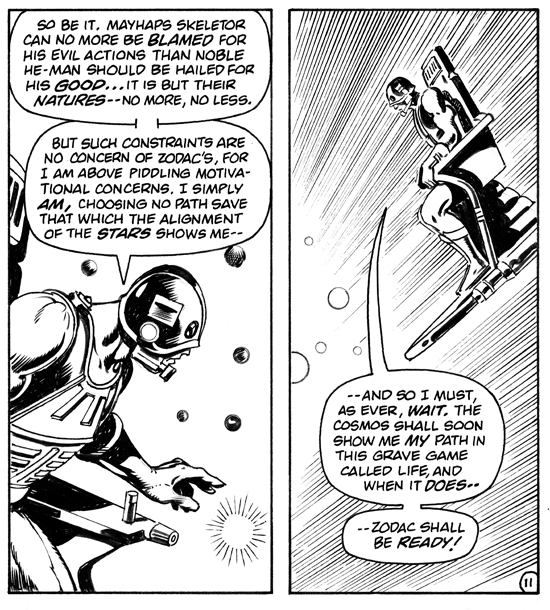
Image source: James Eatock (cleaned up by Jukka Issakainen)
It should be noted that this characterization of Zodac came from DC Comics, not Mattel. Prior to the DC Comics stories, Mattel wanted to position him as a heroic warrior (this was the intention of the designer, Mark Taylor) or as a bounty hunter (an idea that came from Mattel’s marketing department). The bounty hunter thing indicates they still had Star Wars very much in mind – and MOTU was created to compete with Star Wars in the toy aisle.
From author of the DC MOTU series’ perspective, a Jack Kirby influence on Zodac seems to have actually been unintentional, or coincidental. Back in 2010, James Sawyer interviewed Paul Kupperberg, the person who wrote all five comics in the DC series:
James Sawyer: Were you playing homage to any specific genres or stories when fleshing out the He-Man concept? Many fans point to the similarities between Zodac and Metron and naturally assume that the character is loosely based on him.
Paul Kupperberg: None of the above! I don’t remember making the Kirby New Gods connection at the time, although I’m sure I must have seen it had it pointed out to me, but I’m not very big on the whole ‘homage’ thing. You call it ‘homage,’ I call it ‘cheating.’ Kirby already created Metron. If I need Metron, I’ll use Metron, not create a second-generation rip-off that’s not only NOT going to be as good but is going to make people point and see that I don’t have any ideas of my own. Julius Schwartz used to call a certain group of writers he worked with “archaeologists,” because all they ever did was dig up everybody else’s old characters and bits and use them rather than creating something new.
Emphasis added. Read the full interview here.
1987 Masters of the Universe Movie
However, there is at least one clear area of Jack Kirby inspiration in Masters of the Universe. That came in the 1987 Masters of the Universe movie. Director Gary Goddard said:
As the director of Masters of the Universe, it was a pleasure to see that someone got it. Your comparison of the film to Kirby’s New Gods was not far off. In fact, the storyline was greatly inspired by the classic Fantastic Four/Doctor Doom epics, The New Gods and a bit of Thor thrown in here and there. I intended the film to be a “motion picture comic book,” though it was a tough proposition to sell to the studio at the time. “Comics are just for kids,” they thought. They would not allow me to hire Jack Kirby who I desperately wanted to be the conceptual artist for the picture…
I grew up with Kirby’s comics (I’ve still got all my Marvels from the first issue of Fantastic Four and Spider-Man through the time Kirby left) and I had great pleasure meeting him when he first moved to California. Since that time I enjoyed the friendship of Jack and Roz and was lucky enough to spend many hours with Jack, hearing how he created this character and that one, why a villain has to be even more powerful than a hero, and on and on. Jack was a great communicator, and listening to him was always an education. You might be interested to know that I tried to dedicate Masters of Universe to Jack Kirby in the closing credits, but the studio took the credit out.
Gary Goddard
So to sum up so far, we can confirm the 1987 Masters of the Universe Movie plot was partially influenced by Kirby’s Fourth World, Fantastic Four and Thor stories. We also can see, potentially at least, some unconscious influence by Kirby’s Fourth World on the character of Zodac as portrayed in the 1982 DC comics, although it’s possible that it’s just coincidental.
1982 Masters of the Universe Toyline
Over the last couple of years, I’ve noticed a number of videos from former Masters of the Universe Classics Brand Manager Scott Neitlich (whose tenure on the line ran from its beginning in 2008 until 2014). In his YouTube channel, Spector Creative, he’s claimed in several videos that there was a Jack Kirby influence not just on story, but on toy design, including the visual look of Battle Ram, Wind Raider, Beast Man, Skeletor and many others, particularly in the first couple of waves.

Scott’s premise is that Mattel had done some design work in the late 1970s for a potential New Gods toyline. He had found a folder of this material when he was at Mattel, doing some research for the MOTU Classics line. He notes that when designers work on a project that doesn’t go forward, the tendency is to reuse some of that work in future lines. That’s absolutely true, it does happen. For example. Dragon Walker was originally created for a pitch for a new toyline, unrelated to Masters. That line wasn’t greenlit, so Dragon Walker was brought into MOTU. Similarly, an early drawing of a character by Mark Taylor for an unproduced line called Rob-N & the Space Hoods was rebooted as Man-At-Arms in the MOTU line.
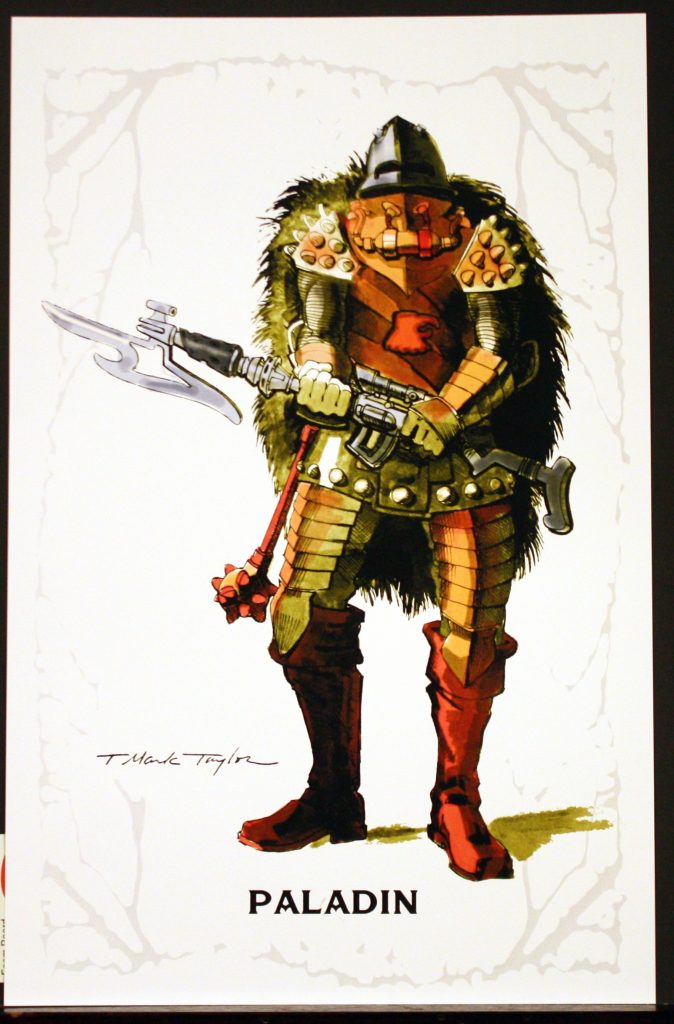
However, because that kind of recycling happens in toy companies does not mean that New Gods concepts were recycled into MOTU. In his video, Scott links characters like Mekaneck, Zodac, Man-E-Faces, Man-At-Arms, Mer-Man, Teela, Battle Cat/Panthor, Battle Ram, and others to the New Gods. However, all of the visual parallels are pretty insubstantial – they are frankly parallels you could make between MOTU and any number of science fiction, fantasy and superhero properties. Often they’re just based on having similar colors.
Below are the images that Scott identifies with existing MOTU characters. As you can see, these are not close matches, but instead are based on existing archetypes and color styles that are far more pervasive than just New Gods or MOTU. I would say that at most both properties were drawing on many of the styles and influences that pervaded pop culture from the 1950s to the 1970s, but that’s true of just about every property of this type really through the 1990s.


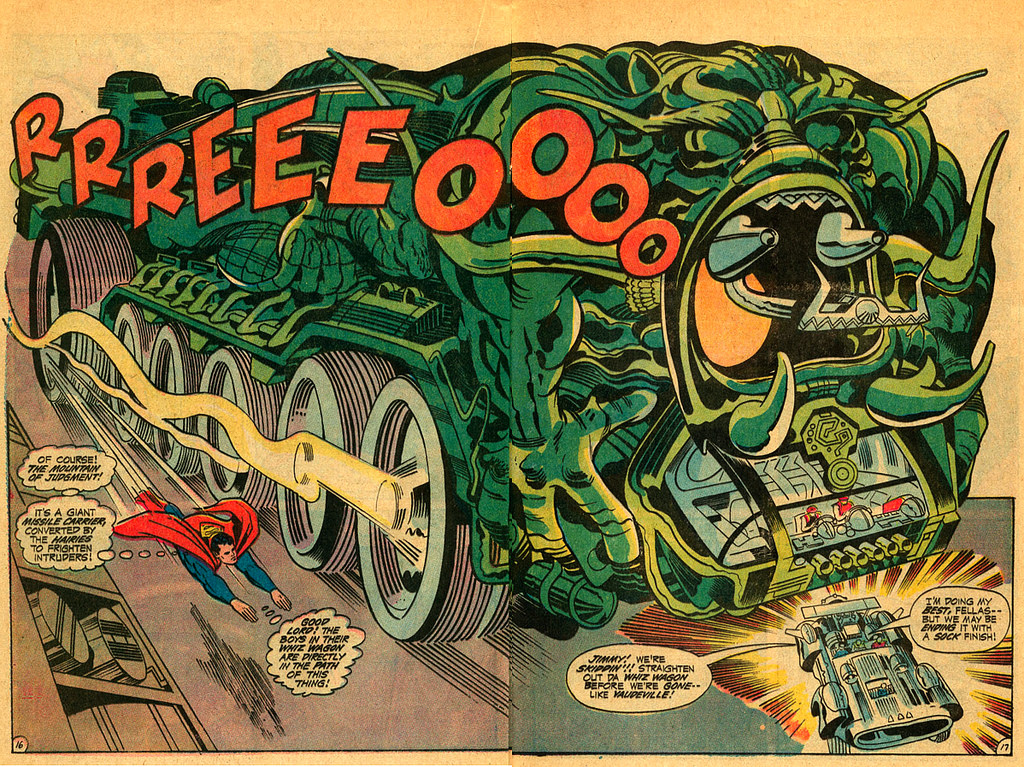

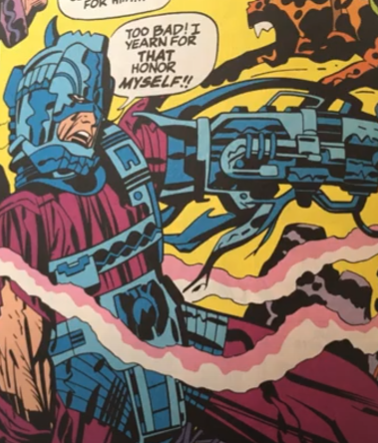
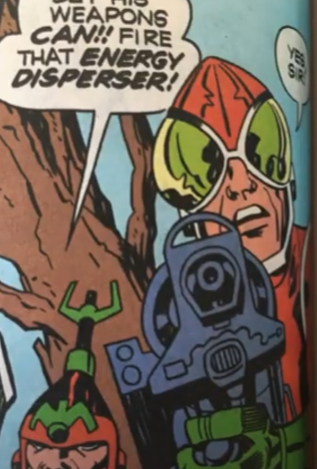



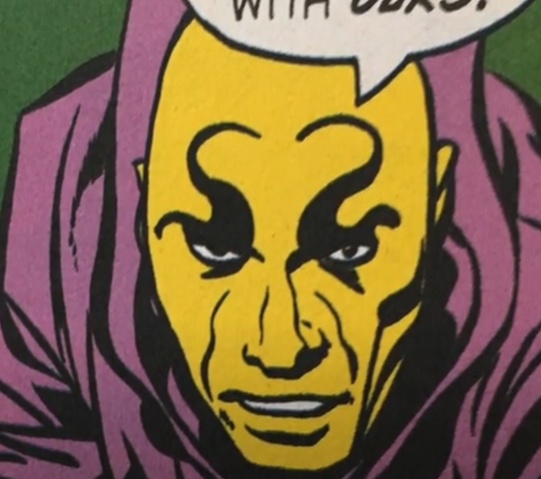
However, I can say it’s very unlikely that Kirby was an influence on Mark Taylor and Ted Mayer for the MOTU line. Between the two of them, they did 100% of the visual design work for the 1982 line of toys, and some of the 1983 line as well. I have in my archives many hours and thousands of words of interviews with Mark Taylor and Ted Mayer, including my own interviews that I did with them for this blog and also for the Dark Horse Toys of He-Man and the Masters of the Universe. They mentioned a lot of influences, including Frank Frazetta, Prince Valiant, conquistadors and knights, Flash Gordon, Star Wars, muscle cars and World War II military aircraft. Never once did either of them mention a Jack Kirby influence. Moreover, I recently reached out to Ted Mayer to ask specifically if there was any Jack Kirby influence on MOTU. He had this to say:
I never heard anyone mention the comic series while we were working on He-Man. The only subject that came up was Frank Frazetta, but that was only in the background, his books were out and every designer was looking at them. All this of course was in the visual design area, I cannot speculate if marketing was looking at this, but I doubt it!
Ted Mayer
Note that Ted Mayer worked with both Mark Taylor (who lead visual design on MOTU for its first year) AND Roger Sweet (who lead the design team for MOTU in its second year and for most of its original run), and he was in a unique position to know if New Gods had had any influence on the line. If he never heard of it having been an influence, it’s very unlikely that it ever was. Mark’s primary work on action figure lines prior to MOTU was mostly on packaging, including for Tarzan and I believe Clash of the Titans and Flash Gordon. Around 1980 he was pulled into creating concept art for various toylines, including Rob’N and the Space Hoods, Miniworld, Masters of the Universe, Giants, Conan (summer 1981) and Kid Gallant. Of those, only MOTU went forward.
In a video about the Grayskull Space Suit, in the comments, Scott also claims that the cardboard space suit inside the original Castle Grayskull was another Kirby design. In response to a fan theory that the space suit was Queen Marlena’s suit that she brought with her from earth, Scott says: “Yeah but it doesn’t really look very ‘earth’, likely because Kirby designed it.”

This is even more far-fetched. The space suit was illustrated by Rebecca Salari Taylor, Mark Taylor’s wife. She worked as a freelance illustrator for Mattel, and was never involved in male action figures until Mark was leading the visual design for the MOTU line. Primarily she worked on Barbie and preschool properties, focusing on fashion design. She said that the labels and cardboard pieces for the castle were based on futuristic icons and previous artwork by Mark to help make MOTU something more than just a Conan or Tarzan-type property. She never worked on any Jack Kirby line.
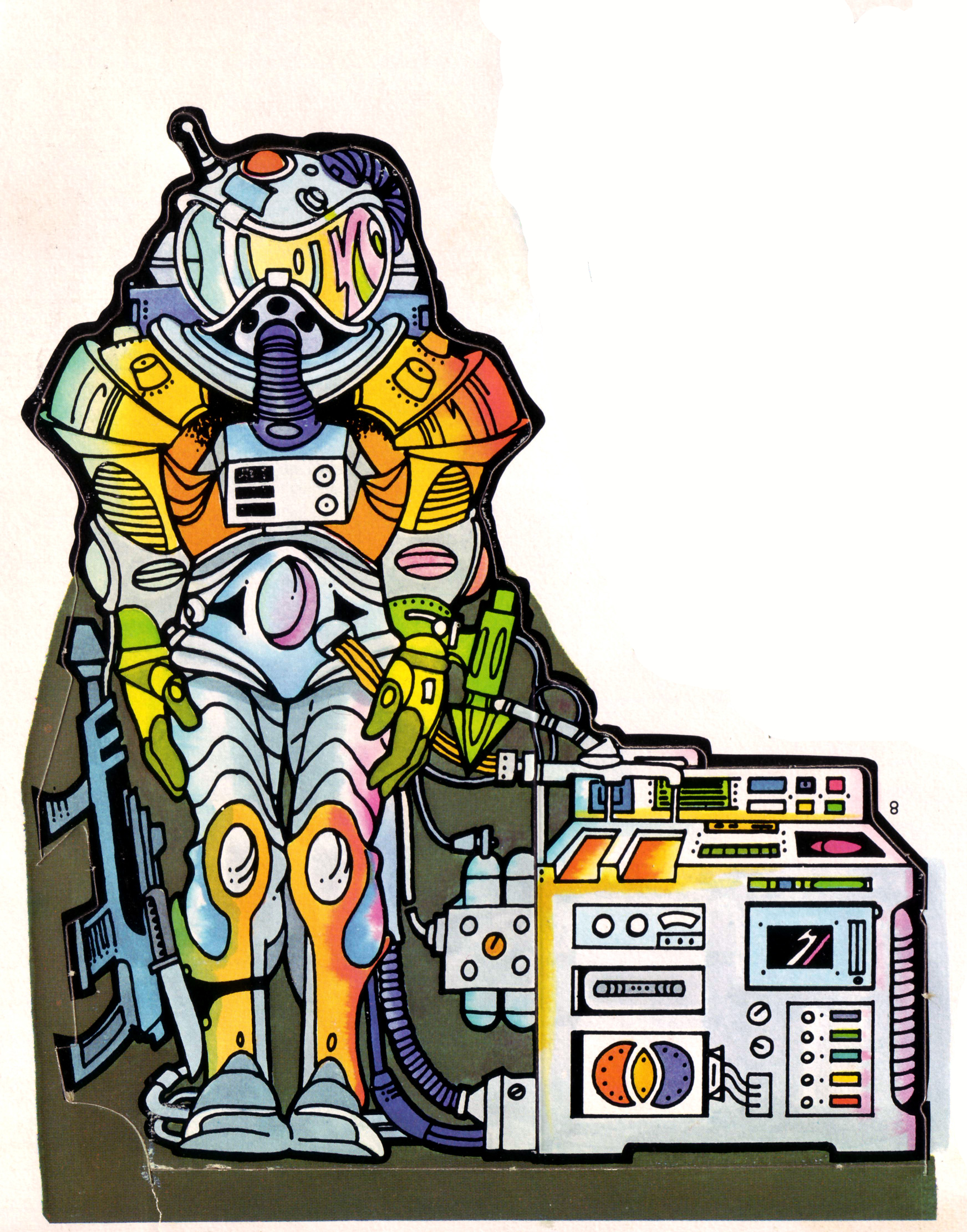
Here is a quick rundown of a few things I can confirm (from direct statements from the creators) influenced some of the toys Scott mentioned in his videos:
- Mer-Man: Bernie Wrightson’s Swamp Thing
- Battle Ram: muscle cars, Star Wars, classic architecture
- Wind Raider: Viking ships (1st version), vintage military aircraft (final version)
- Zodac: Flash Gordon
- Man-E-Faces: Aztec warriors (visual design), and recycling an action feature from Big Jim
- Teela: inspired by Mark’s wife Rebecca as well as this costume
- Man-At-Arms: conquistadores and gladiators
- Beast Man: Chewbacca, existing Big Jim gorilla tooling
- Skeletor: Dia De Los Muertos art, the corpse of Elmer McCurdy at Pike Amusement Park
- Battle Cat: just a creative way of reusing an existing tool (driven by budget and convenience, not by Jack Kirby). Armor inspired by Mark Taylor’s own childhood drawings and redesigned for Battle Cat.
We know Masters of the Universe had a number of visual designers. I thought I’d put together a rough, incomplete timeline of which visual designers ultimately designed the various toys that were released each year. Note that Roger Sweet took the lead in pitching the line to Mattel in 1980, so he did have some influence on the 1982 line, in terms of action feature and the stance of the figures. However, he didn’t come up with the visual design for He-Man, but rather based his barbarian prototype on Mark’s illustrations. When Roger took over the line after Mark Taylor left Mattel, he would often come up with a very basic figure or action feature idea, just a few words on a page (what he calls a “seed idea”), and leave the visual design to members of his team. However, he also designed some figures himself, including Tri-Klops, Mekaneck, Spikor, Two Bad and Sy-Klone.
Visual Design Teams
1982 Series: Mark Taylor, Ted Mayer
1983 Series: Mark Taylor, Ted Mayer, Roger Sweet, Martin Arriola, Colin Bailey
1984 Series: Ted Mayer, Colin Bailey, Roger Sweet, Martin Arriola, Ed Watts
1985 Series: Ted Mayer, Roger Sweet, Martin Arriola, Ed Watts
1986 Series: Ted Mayer, Roger Sweet, Martin Arriola, Ed Watts, John Hollis, Mike Barbato, Mike McKittrick
1987 Series: David Wolfram, Martin Arriola, Mark Jones, Alan Tyler, Ted Mayer, Richard Lepik, Patt Dunn
1988 Series: David Wolfram, Martin Arriola, Alan Tyler
So, as you can see, it’s not just a case of “some Mattel designers worked on a Jack Kirby toyline.” To even begin to make some kind of case for a Kirby influence, we’d need to know who those designers were, just to start. But even that wouldn’t definitively make the case without more positive evidence.
I will say that I also have an extensive archive of Roger Sweet interviews, and he never mentioned a Jack Kirby influence either. I know Martin Arriola came on in 1982 just after Mark Taylor left, so of course he didn’t work on the late-70s Kirby line. David Wolfram didn’t start at Mattel until He-Man had already been going for years.
There’s just no evidence that any aspect of the MOTU toyline was influenced by New Gods. If there was some kind of influence, it would have to be relatively minor. As always, I’m open to any additional evidence that may surface!
Thank you to the following individuals who are current Patreon supporters!
- Philip O.
- MOTU Origins Cork
- Bryce W.
- Ben M.
- Matthias K.
What about the descriptions of Eternia and Infinita in the Halperin bible? Those seem like clear riffs on New Genesis and Apokalips.
That’s certainly possible. It might be worth asking Michael Halperin about it.
Yep. You can pretty much reverse engineer a New Gods movie from the plot of the 1987 MotU movie, with He-Man as Orion, Skeletor as Darkseid, Sorceress as Highfather, Beastman as Kalibak, Gwildor as Metron and the Cosmic Key as the Mother Box. Skeletor’s barge even looks like Darkseid’s Destroyer. But other than the movie there’s not much else.
Fascinating read! Thank you!
Kirby’s influence on MOTU is just one of those ideas that will not die, it seems. I can’t remember which one, but in one of my MOTU books (I think it was the Dark Horse “Art of He-Man and the Masters of the Universe” one), explicity points out Kirby’s apparent influence on characters like Ram Man and Man-E-Faces.
Thanks for the comment, yes, I see it now. I wonder who that came from? It sounds like Scott. Although he is thanked in the book, he is not credited for the content. In any case, I think that it was speculative at the time, and probably not tenable now.